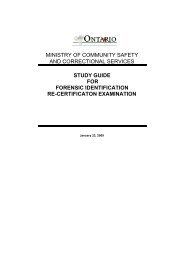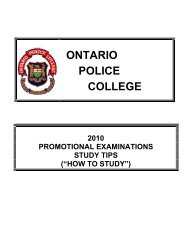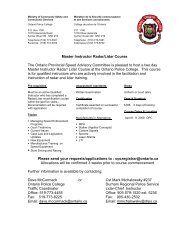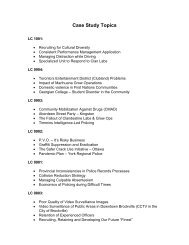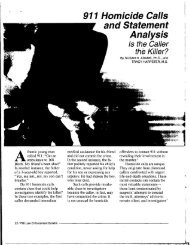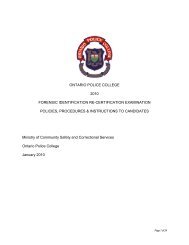General Study Guide - Ontario Police College
General Study Guide - Ontario Police College
General Study Guide - Ontario Police College
You also want an ePaper? Increase the reach of your titles
YUMPU automatically turns print PDFs into web optimized ePapers that Google loves.
Latent Fingerprint Development Processes<br />
*****PLEASE REFER TO O.P.C. TRAINING MANUAL FOR HEALTH AND SAFETY RECOMMENDATIONS*****<br />
Online References – http://www.cbdiai.org/Reagents/main.html (Chesapeake Bay Division, IAI), www.redwop.com (Technical notes), http://www.rcmpgrc.gc.ca/firs-srij/recipe-recette-eng.htm<br />
(RCMP Forensic Identification Services)<br />
Porous Surfaces*** – Proper Development Sequence and Types of Chemical Processes (depending on the circumstances not all processes may apply).** All<br />
processes, however, are post visual and examination of inherent fluorescence by laser or alternate light source including UV.<br />
Development Techniques and ‘Basics’ of Processing<br />
Procedure<br />
Latent Print<br />
Development<br />
Colour<br />
Ridge Detail Visualized By<br />
Method to Record<br />
1. Iodine Fuming*<br />
Requires fuming chamber, ceramic or glass dish and<br />
heat source.<br />
Non-destructive technique<br />
Iodine fumes are more senstive to different latent<br />
residues than other methods.<br />
Clear to dark brown,<br />
often yellowishcoloured<br />
prints.<br />
Physical process by which Iodine vapours<br />
are absorbed by the fatty & oily<br />
components of print residue.<br />
Photograph at the greatest<br />
intensity of colour change.<br />
Developed prints tend to<br />
fade quickly.<br />
2. DFO (1,8-Diazafluoren-9-one) (1988)<br />
Specimen can be dipped or sprayed<br />
Must be dryed & placed in 100C (212F) oven for 10-<br />
20 minutes.<br />
Sometimes pink<br />
prints are<br />
visible. /Yellow<br />
fluorescence.<br />
Chemical reaction with amino acids &<br />
eccrine components of print residue &/or<br />
laser &/or F.L.S. @ 450,485,525,530 nm<br />
using orange goggles for white paper or<br />
laser or F.L.S. @ 570-590nm and red<br />
goggles for manilla envelopes, brown<br />
paper bags and cardboard.<br />
Illuminate with F.L.S. and<br />
photograph with orange or<br />
red camera filter.<br />
3. Ninhydrin<br />
Solution can be applied by dipping, spraying or<br />
painting.<br />
Specimen must be dryed and then heat and<br />
humidity (set @ 60-70%) can be applied to<br />
accelerate development of prints.<br />
Replaced Silver Nitrate (reacts with salt) process<br />
Magenta to deep<br />
purple.<br />
Chemical reaction with amino acids and<br />
proteins in eccrine components of print<br />
residue. Purple coloured compound<br />
produced known as ‘Ruhemann’s Purple’.<br />
Zinc chloride may be used to fluoresce,<br />
and enhance, the ninhydrin developed<br />
ridge detail.<br />
Photograph with a green<br />
filter.



